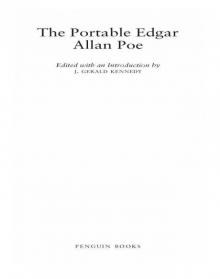- Home
- Edgar Allan Poe
The Raven (Penguin) Page 3
The Raven (Penguin) Read online
Page 3
In its efficiency, Jackson’s prose transmits modernity—she allows the novel to remain crisp and lean. She refuses to overcomplicate her writing with unnecessary description or mannerisms and, therefore, when she delves into detail, she has the reader’s complete attention.
And this is where one of the most genial touches of the novel comes into play. Jackson sets forth the entire endeavor as a scientific experiment, and therefore we are forced to accept the background and history (biography?) of Hill House as pure fact and the parameters of modernity as our safety net.
The experiment as background will again be put to good use by Richard Matheson in the magnificently unsubtle Hell House, but Matheson will choose to solve the novel as a dark riddle, whereas Jackson chooses to let it evolve like a collision course.
And it is here that the kinship with Henry James’s work stops. Rather than maintaining the boundaries of the story as fluid as a question mark—Is it real? Is it not?—Jackson opts for an exclamation point—a fascinating piece of nature documentary: Hill House is the lion pouncing in slow motion toward the smallest, weakest gazelle in the herd: Eleanor.
We are told that this is a house with “insistent hospitality; it seemingly dislikes letting its guests get away,” and one that will disintegrate Eleanor’s sanity and sense of self without ever defining the nature of the evil that animates it. But evil there is, undoubtedly—and this, too, is a characteristic that separates James and Jackson.
Jackson forces us to contemplate all the haunted occurrences through each of the participant’s eyes and vulnerabilities. And by never denying the malevolence of the house: The haunting is real and everyone within it is alone, trapped in their own minds and circumstances, blind to the plight of the others.
This is perhaps one of the most veiled and pervasive horrors in Jackson’s fiction: We are always alone.
If Hill House is a colloquy, then it is a colloquy between the different sides in Jackson’s mind, the many “me’s” that face the vast, hostile world alone. And in the end, Jackson’s misanthropic, nihilistic view of the world seems to assert that, in the darkness, there is a refuge. That if Eleanor needs to belong and Hill House needs to possess, then, finally, in that coupling there might be hope.
The case of Ray Russell offers us a chance to talk about one of the most peculiar horror writers. Russell links postpulp literature and the Grand Guignol tradition with the modern sensibilities of America in the 1960s. Within him resides a neo-paganistic streak that is passed from Algernon Blackwood and Sax Rohmer to him and other writers of unusual proclivities, such as Bernard J. Hurwood. A fascinating combination of the liberal and the heretic.
Russell was born in the early twentieth century and saw action during World War II. He held a variety of jobs and published in a variety of publications. He was part of the resurgence of fantastic literature in American letters. As executive fiction editor of Playboy in the magazine’s infancy (1954–1960), Russell probably knew his share of excess and power, but he utilized this power to provide refuge to a host of valuable genre writers, among them the brilliant Richard Matheson and the precious Charles Beaumont, but heralding the birth of adult fantastic fiction by publishing also Vonnegut, Bradbury, Fredric Brown, and many others.
Russell authored numerous short stories and seven novels—including his most famous one, The Case Against Satan, which pioneers and outlines the plights of Rosemary’s Baby and The Exorcist. But, in spite of this and his continued collaborations with Playboy throughout the 1970s, Russell remains a forgotten writer. A sort of writer’s writer, an acquired taste. This in spite of being a recipient of both a World Fantasy Award and the Bram Stoker Award for Lifetime Achievement.
In fact, in the last few decades, so little has been published about Russell that the only quote, oft repeated, is Stephen King’s blurb, in which he enthrones Sardonicus as “perhaps the finest example of the modern gothic ever written.”
But King, as always, is absolutely right. Russell has a savage streak in his prose, one that would today be considered inappropriate and even offensive and, to me, entirely reminiscent of the Grand Guignol Theatre. But in his best stories he also captures the tenuous atmosphere of the Gothic romance. At a secondary level, Russell seems to wallow in a sadistic impulse akin to the conte cruel so aptly practiced by Auguste Villiers de l’Isle-Adam.
This tortuous vocation is never clearer than in his Gothic S trilogy. The tales Sanguinarius, Sagittarius, and Sardonicus are all surprisingly inventive stories, with shocking twist endings that are here reprinted in their entirety.
My favorite of the three, Sagittarius, may not be a perfect exercise in style, but it is a luscious, devoted repast of Gothic fiction. Sagittarius centers around the tale of two stage actors—the divine Sellig and the revulsive Laval, a freakishly deformed performer who shocks the Grand Guignol audience every night, and who embodies evil to perfection.
If you can guess the not too subtle wordplay hidden in the performers’ names, then it will feel only natural that, in an inspired stroke, Russell links the pair with two more infamous figures of gaslight London: Jack the Ripper and Mr. Hyde. The connection is effortless and feels neither mannered nor insincere and, I guarantee this: It packs a powerful punch in its final pages.
“La vie est un corridor noir / D’impuissance et de désespoir!” cries Laval. “Life is a black corridor of impotence and despair.” Indeed.
Sanguinarius retells—from an unorthodox perspective and with great macabre gusto—the story of Countess Elisabeth Báthory and her thirst for blood. Russell provokes and subverts the tale by adopting the Countess’s point of view. He succeeds in this by infusing the story with period quirks and idioms that lend an air of authenticity to the macabre proceedings.
It is also remarkable to hear the tale told in this manner as we find empathy and reason behind the most atrocious actions. Báthory starts her journey as a virginal bride in her early teens and is swallowed by a vortex of depravity and bloodshed that is described, at times, with zealous excess. In this, Sanguinarius represents an aspect of Russell’s fiction that will erupt in full in Incubus—the capacity of the author to get caught in his own compulsions as he attempts to titillate and shock the reader.
The most famous of his tales, and the only one that is frequently reprinted and discussed, is Sardonicus. First published in Playboy at the end of the 1950s, this is a tale of enormous originality that remains, at the same time, a grand homage and a reinvention of the Gothic. To the eyes of its seemingly straight protagonist, Sir Robert Cargrave, everything in Castle Csejthe is askew and in decay. He has been called there to assist the husband of a former liaison of his—the man in question, the preternaturally pale Mr. Sardonicus, has the lower half of his face paralyzed in a horrid rictus, and the reason for this is too preposterous and delightful to consign in these few lines!
In my opinion, Ray Russell is the literary equivalent of the Italian filmmaker Mario Bava, a supersaturated neo-Gothicist who shines above the premises of his material based on style, conviction, and artistic flair. Sadly, most of Russell’s work has remained unavailable, except for outrageously overpriced paperbacks and expensive collectors’ editions. It is therefore that I take great pride in presenting a new edition of Haunted Castles: The Complete Gothic Stories as part of this Penguin Horror series.
And this brings us to the final title of the series, S. T. Joshi’s edited volume of American Supernatural Tales.
Foremost among the modern scholars of the genre, Mr. Joshi has published many volumes dedicated to the study of the weird tale and has edited many volumes of horror fiction with unparalleled rigor and love. In every respect, he will be a more adept guide than I in taking you hand in hand through the amazing catalog of supernatural fiction he has curated.
So, there you have it. We have prepared a small collection of books that I hope will find their way into the hands of young, strange readers—like I was—curious about this deranged form of storytelling—seeking that late
-night chill, that intimate shiver that happens when the lamia crosses the threshold of our room and whispers at us from the darkened corner.
When the certainty of seeing a monstrous thing takes ahold of us and forces us to gaze at the end of a corridor—there, an apparition stands, a thing of supreme horror. And, as we advance toward it—as in HPL’s “The Outsider”—we are overwhelmed by the realization that the putrid flesh, the vacant eyes, the mad stare we see in that lonely figure is nothing but the reflection in a mirror. A dark mirror facing us.
May your nightmares be plentiful.
GUILLERMO DEL TORO
Thousand Oaks, California, 2013
INTRODUCTION
The work of Edgar Allan Poe (1809–1849) revolutionized and transformed supernatural and psychological horror fiction in so profound and multifaceted a way that it could plausibly be maintained that these genres, as serious contributions to literature, only began with him. The keenness with which Poe analyzed the psychology of fear; the transcendent artistry of his tales, from construction to prose rhythm to aesthetic focus; the intense emotive power of his principal narratives—these and other elements make his work not merely the essential foundation of horror literature but, in many ways, the pinnacle of the genre right up to the present day.
Poe emerged at a critical moment in the history of horror fiction. In the several generations before he began writing, Anglo-American literature had been dominated by the so-called Gothic novel, which had been initiated when Horace Walpole published The Castle of Otranto from his own press on Christmas day 1764. This outlandish and implausible work of supernatural terror perfectly captured the rejection of eighteenth-century classicism represented by Alexander Pope and Samuel Johnson. With a healthy infusion of German Romanticism, it spawned a literary legacy whose pinnacles were such works as Ann Radcliffe’s The Mysteries of Udolpho (1794), Matthew Gregory Lewis’s The Monk (1796), and Charles Robert Maturin’s Melmoth the Wanderer (1820).
Gothic novels, of course, were not in any sense uniform in theme and focus, ranging from pure historical novels to tales of rapid action and adventure, to say nothing of such oddities as William Beckford’s Arabian tale Vathek (1786) and Mary Shelley’s proto–science fiction novel Frankenstein (1818). But many of the four hundred Gothic novels of the period shared certain common features, among them a medieval setting (because it was believed that the superstition that pervaded this period fostered the credibility of supernatural manifestations); the “woman in peril” motif; the Gothic castle, with its hidden rooms and secret chambers; and a dominant male personality, whose Faustian quest—whether it be for all-encompassing knowledge or for the acquisition of wealth and power—served to render him the chief villain of the narrative. Pacts with the devil were common, and ghostly manifestations were not infrequent.
It is not certain how much Gothic fiction Poe read, but the sum total of his remarks—in reviews, essays, letters, and even stories—make it clear that he, like others of his time, regarded the Gothic novel as utterly passé. Poe recognized early on that fear—especially fear of the supernatural—is a fleeting emotion, difficult or impossible to sustain over the length of a novel. Accordingly, he turned his attention to embodying fear within the parameters of the short story.
It has long been acknowledged that Poe is the virtual inventor of the short story as we know it; but of course short stories had been written before Poe. In the United States he had been preceded by Washington Irving, whose Tales of a Traveller (1824) and other volumes contained liberal doses of weirdness. Poe himself read the occasional weird tales that were published in Blackwood’s Edinburgh Magazine, a periodical founded in 1817. When he wrote his first short stories in the early 1830s, he may well have used the stories in Blackwood’s as examples. His “Metzengerstein” is little more than a compact little Gothic tale, complete with a castle, a supernatural horse, and other related motifs.
But Poe remains a critical figure in the development of the short story in his emphasis on what he called the “unity of effect.” By this he meant that a story should focus on a single basic incident, and that every scene, every paragraph, even every single word of the tale must contribute directly or indirectly to the final outcome. Poe himself practiced what he preached brilliantly, producing a succession of tales of unparalleled concision, focus, and cumulative power.
Why did Poe write tales of horror and the supernatural? No definitive answer can be given to this question; the fact remains that he was attracted to the weird and bizarre for the whole of his career, even when writing tales that were ostensibly comic or parodic. Poe did little theorizing on the nature of weird fiction, but a single sentence in the preface to his landmark collection, Tales of the Grotesque and Arabesque (1840), is worth citing. Poe had taken umbrage when some critics claimed that his tales were merely copies of German models, and he threw down this gauntlet: “If in many of my productions terror has been the thesis, I maintain that terror is not of Germany, but of the soul.” By this Poe meant that he would focus on the effects of fear upon human psychology rather than on the mechanical stage properties of an outworn Gothicism.
The result is an unprecedented array of supernatural fiction that laid the groundwork for much of the work that followed in this genre: psychic possession in “Ligeia” and “The Fall of the House of Usher”; supernatural revenge in “The Black Cat”; the weirdness of remote places in “MS. Found in a Bottle” and “A Descent into the Maelström”; the dangers of untrammeled science in “The Facts in the Case of M. Valdemar.” Other tales tread the nebulous borderline between life and death in a haunting, incantatory language that—as in “Shadow—A Parable” and “The Masque of the Red Death”—is as much poetry as prose.
Psychological horror—the horror inherent in aberrant human behavior—seems to have been even closer to his temperament. The grisliness of revenge in “The Cask of Amontillado” and “Hop-Frog”; the loathsomeness of torture in “The Pit and the Pendulum”; successive waves of horror and death in The Narrative of Arthur Gordon Pym; extreme psychological aberration in “Berenice,” “The Tell-Tale Heart,” and “The Man of the Crowd”—these and other tales show Poe to be a master of a psychological suspense that does not require the supernatural to engender fear.
Poe’s poems are also full of weirdness and horror, although here he had a far more distinguished array of predecessors, ranging from Coleridge (The Rime of the Ancient Mariner, 1798) to Keats (Lamia, 1820) and including Goethe, Schiller, Sir Walter Scott, and many others. For all their familiarity, such poems as “The Raven” and “Annabel Lee” retain their power to terrify, while the unearthly landscapes of “The City in the Sea” and “Ulalume,” the bleak pessimism of “The Conqueror Worm” and “For Annie,” and the cosmic speculation of “Dream-Land” establish Poe as a touchstone for weird verse.
Poe’s influence on subsequent horror literature is incalculable. Ambrose Bierce, H. P. Lovecraft, M. R. James, and Walter de la Mare all the way down to Stephen King, Ramsey Campbell, and Thomas Ligotti all owe a deep debt to Poe’s pioneering dissection of the psychology of terror, his deliberately frenetic and flamboyant prose, and the sheer originality of his weird conceptions. If any author can be said to have single-handedly founded the genre of weird fiction, that author is Edgar Allan Poe.
S. T. JOSHI
A NOTE ON TEXTS
The texts of Poe’s published works are in the public domain. This Penguin Horror volume was selected and edited in consultation with S. T. Joshi. Interested readers should turn to the Penguin Classics edition of The Portable Edgar Allan Poe (2006) for an introduction, chronology, notes, and bibliography by J. Gerald Kennedy.
Years listed on the contents page refer to dates of writing; multiple dates next to a title refer to revisions of that text.
THE
RAVEN
Tales
METZENGERSTEIN
Pestis eram vivus—moriens tua mors ero.
MARTIN LUTHER
orror an
d fatality have been stalking abroad in all ages. Why then give a date to this story I have to tell? Let it suffice to say, that at the period of which I speak, there existed, in the interior of Hungary, a settled although hidden belief in the doctrines of the Metempsychosis. Of the doctrines themselves—that is, of their falsity, or of their probability—I say nothing. I assert, however, that much of our incredulity (as La Bruyère says of all our unhappiness) “vient de ne pouvoir ětre seuls.”*
But there are some points in the Hungarian superstition which were fast verging to absurdity. They—the Hungarians—differed very essentially from their Eastern authorities. For example, “The soul,” said the former—I give the words of an acute and intelligent Parisian—“ne demeure qu’une seule fois dans un corps sensible: au reste—un cheval, un chien, un homme màeme, n’est que la ressemblance peu tangible de ces animaux.”
The families of Berlifitzing and Metzengerstein had been at variance for centuries. Never before were two houses so illustrious, mutually embittered by hostility so deadly. The origin of this enmity seems to be found in the words of an ancient prophecy—“A lofty name shall have a fearful fall when, as the rider over his horse, the mortality of Metzengerstein shall triumph over the immortality of Berlifitzing.”
To be sure the words themselves had little or no meaning. But more trivial causes have given rise—and that no long while ago—to consequences equally eventful. Besides, the estates, which were contiguous, had long exercised a rival influence in the affairs of a busy government. Moreover, near neighbors are seldom friends; and the inhabitants of the Castle Berlifitzing might look, from their lofty buttresses, into the very windows of the Palace Metzengerstein. Least of all had the more than feudal magnificence, thus discovered, a tendency to allay the irritable feelings of the less ancient and less wealthy Berlifitzings. What wonder, then, that the words, however silly, of that prediction, should have succeeded in setting and keeping at variance two families already predisposed to quarrel by every instigation of hereditary jealousy? The prophecy seemed to imply—if it implied anything—a final triumph on the part of the already more powerful house; and was of course remembered with the more bitter animosity by the weaker and less influential.

 The Works of Edgar Allan Poe — Volume 2
The Works of Edgar Allan Poe — Volume 2 The Works of Edgar Allan Poe — Volume 1
The Works of Edgar Allan Poe — Volume 1 The Works of Edgar Allan Poe — Volume 3
The Works of Edgar Allan Poe — Volume 3 The Works of Edgar Allan Poe — Volume 5
The Works of Edgar Allan Poe — Volume 5 The Works of Edgar Allan Poe — Volume 4
The Works of Edgar Allan Poe — Volume 4 The Tell-Tale Heart
The Tell-Tale Heart The Raven (Penguin)
The Raven (Penguin) The Paris Mysteries
The Paris Mysteries Tales of Terror from Edgar Allan Poe
Tales of Terror from Edgar Allan Poe The Fall of the House of Usher
The Fall of the House of Usher The Golden Book of World's Greatest Mysteries
The Golden Book of World's Greatest Mysteries The Narrative of Arthur Gordon Pym of Nantucket
The Narrative of Arthur Gordon Pym of Nantucket Ligeia
Ligeia The Landscape Garden
The Landscape Garden Complete Tales & Poems
Complete Tales & Poems Great Tales and Poems of Edgar Allan Poe
Great Tales and Poems of Edgar Allan Poe The Colloquy of Monos and Una
The Colloquy of Monos and Una The Oblong Box
The Oblong Box Thou Art the Man
Thou Art the Man A DESCENT INTO THE MAELSTROM
A DESCENT INTO THE MAELSTROM THE MURDERS IN THE RUE MORGUE
THE MURDERS IN THE RUE MORGUE The Business Man
The Business Man The Mystery of Marie Rogêt
The Mystery of Marie Rogêt Metzengerstein
Metzengerstein The Man That Was Used Up
The Man That Was Used Up William Wilson
William Wilson The Philosophy of Composition
The Philosophy of Composition The Portable Edgar Allan Poe
The Portable Edgar Allan Poe Bon-Bon
Bon-Bon A Predicament
A Predicament The Premature Burial
The Premature Burial The Angel of the Odd
The Angel of the Odd The Man of the Crowd
The Man of the Crowd Never Bet the Devil Your Head
Never Bet the Devil Your Head The Tell-Tale Heart and Other Writings
The Tell-Tale Heart and Other Writings The System of Doctor Tarr and Professor Fether
The System of Doctor Tarr and Professor Fether Selected Tales (Oxford World's Classics)
Selected Tales (Oxford World's Classics) Essential Tales and Poems of Edgar Allan Poe (Barnes & Noble Classics Series)
Essential Tales and Poems of Edgar Allan Poe (Barnes & Noble Classics Series) MS. Found in a Bottle
MS. Found in a Bottle Some Words with a Mummy
Some Words with a Mummy The Science Fiction of Edgar Allan Poe (Penguin Classics)
The Science Fiction of Edgar Allan Poe (Penguin Classics) King Pest
King Pest CRITICISM
CRITICISM How to Write a Blackwood Article
How to Write a Blackwood Article Mystification
Mystification Diddling Considered as One of the Exact Sciences
Diddling Considered as One of the Exact Sciences Steampunk Poe
Steampunk Poe The Literary Life of Thingum Bob, Esq.
The Literary Life of Thingum Bob, Esq. Classic Crime Collection
Classic Crime Collection Complete Stories and Poems of Edgar Allen Poe
Complete Stories and Poems of Edgar Allen Poe Berenice
Berenice The Black Cat
The Black Cat The Slender Poe Anthology
The Slender Poe Anthology The Science Fiction of Edgar Allan Poe
The Science Fiction of Edgar Allan Poe The Assignation
The Assignation The Thousand-and-Second Tale of Scheherazade
The Thousand-and-Second Tale of Scheherazade The Raven and Other Short Stories
The Raven and Other Short Stories The Spectacles
The Spectacles Hop-Frog
Hop-Frog The Purloined Letter
The Purloined Letter Mellonta Tauta
Mellonta Tauta The Balloon-Hoax
The Balloon-Hoax Landor's Cottage
Landor's Cottage Mesmeric Revelation
Mesmeric Revelation The Pit and the Pendulum
The Pit and the Pendulum